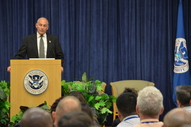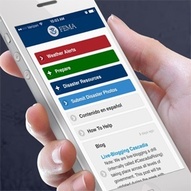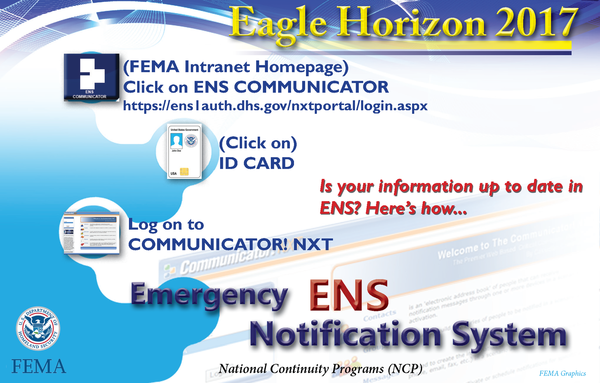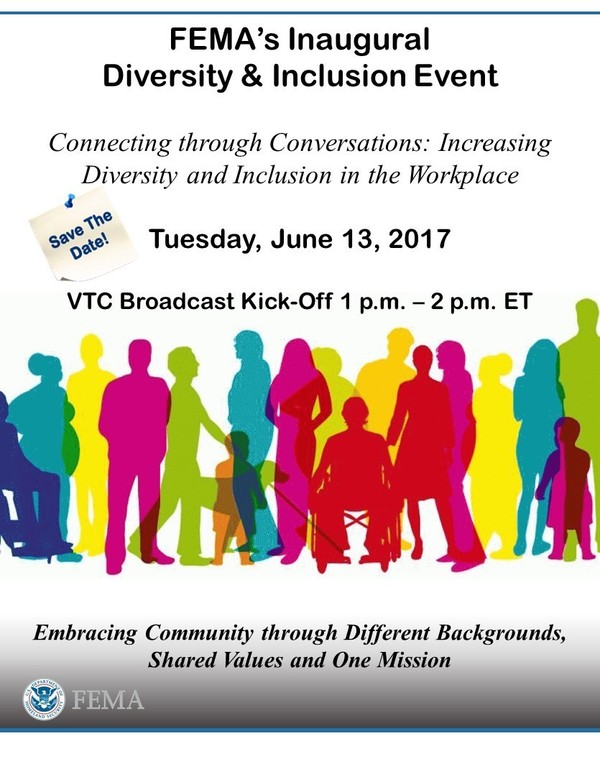 FEATURED ARTICLES
|
On May 25, the National Oceanic and Atmospheric Administration
(NOAA) issued its hurricane outlook for 2017. For the upcoming Atlantic
hurricane season, which runs from June 1 through Nov. 30, forecasters predict a
45 percent chance of an above-normal season, a 35 percent chance of a
near-normal season, and only a 20 percent chance of a below-normal season.
Acting FEMA Administrator Bob Fenton urged the public to get ready
now with some easy, low-cost steps that will leave families better
prepared. “Have
a family discussion about what you will do, where you will go, and how you
will communicate with each other when a storm threatens. Download the FEMA App to your mobile device
to get alerts and listen to the local authorities as a storm approaches.” FEMA employees are reminded to ensure their information is updated in the Deployment Tracking System (DTS).
In addition to the seasonal
prediction, analysts also discussed forecasting
improvements at NOAA’s National Hurricane Center (NHC) this year. Beginning this year, the public will be able to
click on the hurricane
track cone graphic and see how far outside of the cone hurricane and
tropical-storm-force winds extend, which can be hundreds of miles.
NOAA's seasonal hurricane forecasts
are comprised of three separate outlooks: the Central Pacific Hurricane
Outlook, the Eastern Pacific Hurricane
Outlook, and the North Atlantic
Hurricane Outlook.

The Federal Employee Viewpoint
Survey (FEVS) is underway. On May 11, the Office of Personnel Management (OPM)
sent the FEVS to the FEMA email addresses of a randomly selected group of
permanent full-time employees, temporary full-time employees, part-time
employees, all COREs, and Reservists. The survey results translate into a better workplace for FEMA employees and better service for the communities we serve.
We are slightly ahead of where we were last year during the first week of the survey. For those
who received the survey, you will get weekly prompts from the Office of
Personnel Management to complete the survey. Once you complete the survey, the
weekly reminders will cease. Check your FEMA email account. If you got the
survey complete it today.
For selected Title 5 employees,
including permanently employed, non-political, non-seasonal,
full/part-time employees on board as of October 2016:
Look for an email from: EVHS@opm.gov
The subject line: 2017
Federal Employee Viewpoint Survey
For Stafford Act employees,
including Reservists, COREs and temporary full-time employees:
Look for an email from: USASurvey@opm.gov
The
subject line: FEMA 2017 Stafford Act Employee Viewpoint Survey
FEMA
values the efforts and contributions of Stafford Act employees, therefore the
Office of the Chief Component Human Capital Officer contracted with OPM to issue the
survey to all Reservists, COREs, and Temporary-Full-Time employees. For
both groups, the survey will run for six-weeks and will end on Thursday, June 22.
Those
who received the 2017 FEVS are among a select few who have been asked to
complete the survey this year. Your voice counts!
On May 23, President
Donald J. Trump delivered his Fiscal Year (FY) 2018 Budget to Congress. The
FY 2018 spending plan requests $44.1 billion in discretionary budget
authority for DHS, which is a $2.8 billion increase from FY 2017. The
budget reflects continued commitment to the security of our homeland and
the American public. More information about the budget will be shared in
the coming days. And, you can also read more about the budget on DHS
Connect.

On
May 16, DHS Secretary John F. Kelly spoke to more than 100 employees from
several DHS component agencies at a town hall meeting in Chicago.
The meeting was held in the same building that is home to the FEMA Region V
Office. Secretary Kelly spoke about the importance of the DHS mission and the
vital role each component agency has in keeping the Nation safe. During his
remarks, the Secretary praised FEMA employees for their hard work and
dedication.
|

In
the next few months, the Office of the Chief Information Officer (OCIO) will be
sending new identity credentials (called derived credentials) to employees who
use a cell phone or other mobile device. The new credentials, which will allow
employees to log in to their mobile device using a pin number or fingerprint,
are required for changes to the Agency’s mobile device management policies. The
changes will improve security encryption and protection and help prevent
non-authorized users from accessing information on your FEMA phone or mobile device.
The first group of users to transition to the new credentials will be those who currently use an RSA
Token to log in to the FEMA network from their mobile device. RSA Tokens
will expire on May 31, 2017, therefore this group must have the derived
credentials on their mobile devices before the expiration date. All other remaining users will transition by Sep 30, 2017. At that time employees will receive an email containing
instructions on how to install derived credentials and
additional details about how to save all data on your device.
For more information, please visit the derived credentials Intranet page.
|

On May 11, the
Philadelphia Federal Executive Board (FEB) hosted the 2017 Excellence in
Government Awards. The ceremony recognizes the achievements of Federal
agencies, offices, and employees in several categories. FEMA Region III
was nominated for 12 awards and won two of those. They took home the group gold
award in the “Outstanding Community Service” category for their response
and recovery efforts in West Virginia following the severe storms, flooding,
landslides, and mudslides that hit that state last year and resulted in
it being declared a major disaster (DR-4273).
Private Sector Liaison Stephanie Pyle won an individual bronze medal in
the “Improved Federal Image” category, based on her work with the private
sector, which included a series of tabletop exercises. These exercises were recognized as a
FEMA best practice.
|
 The Reservist Report is an opportunity to learn more about FEMA Reservists. FEMA Weekly welcomes your articles.
Chameka Meadows is a Disability Integration Advisor deployed to North Carolina for Hurricane Matthew (DR-4285). She is assigned to FEMA’s Disability Integration (DI) Cadre and works with the Transitional Sheltering Assistance Program, which helps address the basic needs of disaster survivors.
Meadows works with Individual Assistance (IA) and state social workers, to identify sheltering needs, align resources, and make referrals. Additionally, she has provided crisis intervention to some survivors, who were overwhelmed during the application process.
|
FEMA’s
primary alert and notification source to distribute emergency communications to
employees is the Emergency Notification System (ENS)? ENS is operated and
managed by the FEMA Operations Center (FOC). For more information on ENS,
contact your Component Continuity of Operations Point of Contact (COOP
POC).


Delivering housing for survivors after a disaster is one
of FEMA’s most important missions. Based on experience from previous
direct housing missions, FEMA’s approach to providing post-disaster housing
has evolved. After an in-depth, critical look at the Agency’s post-disaster
housing strategy, the Recovery Directorate convened a Housing Summit in
February 2017. The Summit included the participation of FEMA leadership,
as well as several stakeholders including the U.S. Department of Housing
and Urban Development (HUD) and the U.S. Army Corps of Engineers. Insight
and guidance from the Summit helped form the Housing Assistance
Initiative.
The Initiative will identify and implement innovative
solutions to improve the way the Agency manages, provides, and maintains
housing for disaster survivors. FEMA employees are participating in
13 working groups, including direct repair, disaster housing assistance
team modernization, and analysis of potential legislative and regulatory
proposals. The Initiative is also conducting feedback sessions to solicit
responses from employees and is on track to rollout a Disaster Housing
Strategy by the end of the summer.
Should you have questions about the Housing Assistance
Initiative, please send them to: FEMA-housing-assistance-initiative@fema.dhs.gov.
|

If your
official travel is cancelled for any reason, you are fully responsible for
cancelling your reservations. The Office of the Chief Financial Officer (OCFO)
has prepared a Travel Pocket Guide as a basic reference for FEMA employees
preparing for travel. It contains basic travel Do’s and Don’ts and other
information employees need to know when they travel. Request your copy of the
FEMA Travel Pocket Guide by sending an email to the Travel Policy mailbox at FEMA-TravelPolicy@fema.dhs.gov, and
write FEMA TRAVEL POCKET GUIDE in the subject line.
Employees can locate
additional information related to their travel needs in the Travel
Toolbox on
the Intranet homepage. OCFO is offering
travel policy briefings to all Program Offices, including the Regions. To
request a travel policy briefing, please send an email to the FEMA Travel
Policy mailbox at FEMA-TravelPolicy@fema.dhs.gov.
|

The Diversity Advisory Management
Council (DMAC) is sponsoring an agency-wide Diversity and Inclusion (D&I)
video teleconference (VTC) on Tuesday, June 13, from 1 p.m. - 2 p.m., ET.
The theme is Connecting through Conversations: Increasing Diversity
and Inclusion in the Workplace.
The VTC
will start with opening remarks from FEMA Acting Administrator Bob
Fenton. Keynote speaker Bruce Stewart, formerly with the Office of
Personnel Management (OPM) and a leading authority on Diversity and Inclusion
in the Federal government, will speak about the importance of
having meaningful conversations to establish connections. Following the VTC, many FEMA Regions and
locations will host additional activities for the day. To find out what
what’s happening at your location, please contact one of the coordinators
below.
HQ - myra.shird@fema.dhs.gov
R1 - donna.nelson@fema.dhs.gov
R2 - zandra.gill@fema.dhs.gov
R2 - michele.sturman@fema.dhs.gov
R3 - jennifer.garcia@fema.dhs.gov
R4 - randall.hecht@fema.dhs.gov
R4 - donald.williams1@fema.dhs.gov
R5 - jean.baker@fema.dhs.gov
R5 - duane.castaldi@fema.dhs.gov
R6 - patricia.mancha@fema.dhs.gov
R6 - melanie.king1@fema.dhs.gov
R7 - ronald.j.jackson@fema.dhs.gov
R7 - marlena.valdivia@fema.dhs.gov
R8 - luisa.rivera@fema.dhs.gov
R9 - xushie.brue@fema.dhs.gov
R10 - jay.laplant@fema.dhs.gov
NETC - angela.cunningham@fema.dhs.gov
|